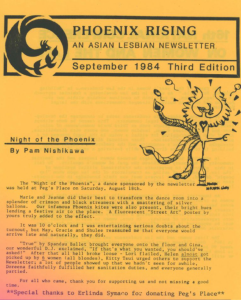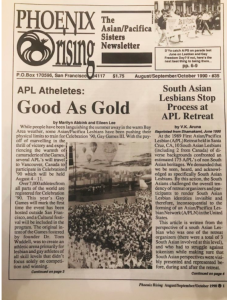As a result of deep-rooted cultural stigmas surrounding homosexuality, queer Asian American communities were slow in gaining traction during the Second Wave Movement: “As a little kid, I was afraid of two things: / Being Yellow / and being Queer” (Wong 53).

A cover from the September 1984 publication of the periodical, Phoenix Rising, which operated from 1984 to 1990, featured in “Finding Community in the Past”
Moreover, the lack of representation in lesbian periodicals such as Sinister Wisdom rendered Asian lesbians desperate for representation. In consequence, a diverse collection of Asian lesbians, “Lori Lai, May Lee, Susan Lee, Pam Nishikawa, Gisele Pohan, Marie Shim, Doreena Wong, and Zee Wong,” formed Phoenix Rising, a San Francisco-based newsletter dedicated to the representation of queer Asian and Pacific voices (See). Through periodicals like Phoenix Rising, lesbian Asian Americans worked to dismantle the notion that queerness is a Western concept incompatible with non-Western ideologies and cultures.
During the Second Wave, the underrepresentation of Asian voices was further exacerbated by the prioritization of East Asian matters over those of other Asian communities. Spaces that were dedicated to the lack of queer Asian voices welcomed South Asian lesbians and activists, reflecting editors’ focus on equal representations of all Asian ethnicities. In response to the ostracization of South Asians, “V.K. Aruna (who was one of the South Asian organizers of the “Coming Together, Moving Forward” retreat) wrote of how she and other South Asian lesbian women felt ostracized and overlooked” (Swift).

This section of the Phoenix Rising periodical features Aruna’s criticism, which highlights the editors’ efforts towards inclusion in the lesbian community, published in “Exploring Black and Asian American Lesbian Archives: Aché and Phoenix Rising”
Aruna’s critical opinion piece was published in the fall 1990 issue of Phoenix Rising, pushing editors to diversify their direction to facilitate harmony within the Asian American lesbian community. Further, Brooklynites Utsa and Kayal established, Anamika, a periodical dedicated to showcasing queer South Asian experiences as a response to the erasure of their voices in larger activist spheres. As such, these small-scale editorials created communities in which suppressed subcultures of Asian Americans freely expressed their frustrations and formed connections: “When I first came out as a lesbian thirteen years ago, I thought I was the only Asian Lesbian in the world. It was very uplifting to look around our circle and see so many women of all ages and backgrounds together in one place” (Tsui).
Sources:
See, Sophia Yuet. “Finding Community in the Past.” Futuress, Feminist Findings, 20 Nov. 2020, https://futuress.org/magazine/phoenix-rising/. Accessed 07 Dec. 2021.
Swift, Jaimee. “Exploring Black and Asian American Lesbian Archives: Aché and Phoenix Rising.” Asian American Writers’ Workshop, The Margins, 25 Mar. 2021, https://aaww.org/exploring-black-and-asian-american-lesbian-archives-ache-and-phoenix-rising/. Accessed 06 Dec. 2021.
Wong, Christine. “An Oral History of Lesbianism.” Frontiers: A Journal of Women Studies, vol. 4, no. 3, University of Nebraska Press, 1979, pp. 52–53.
